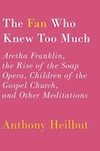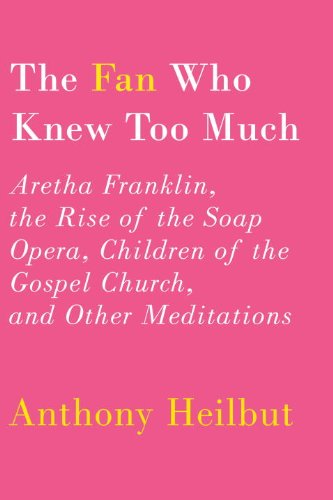 The Fan Who Knew Too Much: Aretha Franklin, The Rise of Soap Opera, Children of the Gospel Church, and Other Meditations
The Fan Who Knew Too Much: Aretha Franklin, The Rise of Soap Opera, Children of the Gospel Church, and Other Meditations
by Anthony Heilbut
Knopf. 368 pages, $30.
THERE ARE FANS, and then there are fanatics. Count among the latter the many gay men who have bonded so powerfully with various musical genres, famously including the Broadway musical, club disco, and opera—each with its own set of divas and devotional practices. Less well known are the many gay men who are devotees of gospel music. These so-called gospel sissies are no less committed to their music and no less central to its existence, but their relationship to their music has always been much more complicated. This fraught fandom is the organizing focus of Anthony Heilbut’s new book, The Fan Who Knew Too Much.
Like D. A. Miller in his meditative essay on the Broadway musical, Place for Us (1998), or Wayne Koestenbaum in the cult classic The Queen’s Throat (1993), Heilbut recounts having been a fan for almost his entire life. As a teenager in the 1950’s, he took the advice of an usher at Harlem’s Apollo Theater and attended a gospel show. He was hooked, and would later become a proselytizer for gospel music. And he has made a career out of his obsession: Heilbut’s 1971 book, The Gospel Sound, was the first history of black gospel music, and he went on to produce award-winning albums of gospel’s golden-age all-stars, including Dorothy Love Coates, Mahalia Jackson, and Marion Williams.
In The Fan, Heilbut reflects at length on being a fan extraordinaire, covering a lifetime’s worth of closely cultivated interests—soap operas, émigré literature, and the male soprano among them. But this is no retiring twilight reverie. At the book’s emotional center are its gospel chapters, in which Heilbut meditates evocatively on the place and plight of “the children”—black gospel’s poetic euphemism for the music’s many homosexual fans and performers.
I study and write about gospel professionally (in my case, the southern white variety), and as a gay fan and scholar of the music, it has been my experience that behind every gospel song, there’s a gay man somewhere—whether writing, producing, singing, playing, selling, buying, or just enjoying it. Heilbut goes further: “It is impossible to understand the story of black America without foregrounding the experiences of the gay men of gospel.”
It’s a tricky story to tell. During black gospel’s golden age (1945 to 1960), “most of the male gospel stars were gay,” writes Heilbut, including, most famously, James Cleveland, Robert Anderson, and Alex Bradford. So were innumerable fans, among them James Baldwin, Al Duckett, and Bayard Rustin, whose influence on the Civil Rights Movement Heilbut links to the fundamentally queer æsthetic of black gospel. Yet because of the stigma surrounding homosexuality in the church, the gay men of gospel have long been ’buked and scorned, as the old song puts it, and their history strategically overlooked and purposefully effaced.
In recovering the story of the children—“battered by poverty, racism, and homophobia” and struggling to “get over,” as the gospel folk say—Heilbut draws on a repertoire of vividly emblematic anecdotes, personal histories, and first-hand experiences that bear a deeply felt witness to gospel’s gayness. Writes Heilbut: “I have seen five-man groups weep and stagger as they sang, ‘When sorrow has taken my heart by surprise, He never has left me alone,’ or ‘I do not know how long it will be, or what the future holds for me.’ They’ll wave glad hands when some old mother exhorts them, ‘Children, take it to Jesus, you don’t need to tell nobody else. Just step into your secret closet.’”
Heilbut has spent most of his life studying, befriending, and being a fan of many gospel greats for whom that secret closet has been—and for many more still is—a lived reality. So he knows the score, and he tells it in a style by turns tragic, bawdy, transporting, and, as in this scene, balefully beautiful. At its best, the result is a dishy yet devotional guide to gay sense and sensibility that defined black gospel’s mid-20th-century heyday. What D. A. Miller did for show queens and Wayne Koestenbaum for opera queens, Heilbut does for the gospel sissies: he eloquently redeems the half that has not been told about gay lives and contributions to an American music tradition well known for its willfully averted gazes, sneering dismissals, and outright denials of gay existence.
But whereas Miller and Koestenbaum offer themselves as prototypical every-queens, Heilbut writes as a foreign correspondent who fell in love with a difficult mistress and never really came home from assignment. And the story he tells is not always pretty. Today’s gospel church—black and white alike—is dominated by evangelists of a “name-it-and-claim-it” prosperity gospel. These celebrity preacher-divas rely on a flamboyantly emotional style steeped in the same deeply gay sensibility that underlies gospel music, even as fierce opposition to homosexuality is the modern saint’s truest proof of piety. It’s a mordant irony: “a style mastered by gay men [is]now deployed by their enemies” across the spectrum of race, class, and culture.
For Heilbut, the gospel sissy embodies a dilemma common to all cultural exiles and social outcasts who haunt the pages of his book: how to be in a world that relies on and even benefits from the very thing about you that it refuses to accept. With The Fan, Heilbut turns his haunted fascination with this dilemma into a meditative reckoning with the struggle to “get over” for all those who are exiled among their own people.






